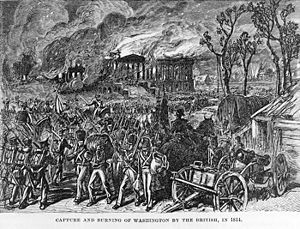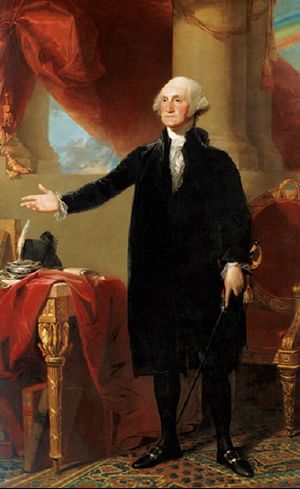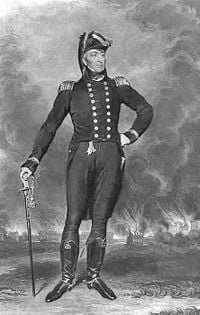Burning of Washington
| Burning of Washington | |||||||
|---|---|---|---|---|---|---|---|
| Part of the War of 1812 | |||||||
 "Capture and burning of Washington by the British, in 1814," 1876 drawing. | |||||||
| |||||||
| Combatants | |||||||
| Great Britain | United States | ||||||
| Commanders | |||||||
| Robert Ross George Cockburn |
Unknown | ||||||
| Strength | |||||||
| 4,250 | Unknown | ||||||
The Burning of Washington is the name given to the razing of Washington, D.C., by British forces in 1814, during the War of 1812. Strict discipline and the British commander's orders to burn only public buildings are credited with preserving most residences, and as a result the facilities of the U.S. government were largely destroyed. The attack was in retaliation for the U.S. invasion of York, Upper Canada (now Toronto, Ontario, Canada), at the Battle of York in 1813, in which U.S. forces looted and burned the city, including the Parliament Buildings of Upper Canada.
The Burning of Washington
On August 24, 1814, the advance guard of British and Canadian troops marched to Capitol Hill; they were too few in number to occupy the city, so Ross intended to destroy as much of it as possible. He sent a party under a flag of truce to agree to terms, but they were attacked by partisans from a house at the corner of Maryland Avenue, Constitution Avenue, and Second Street NE. This was to be the only resistance the soldiers met. The house was burned, but the soldiers were infuriated, and the Union Flag was raised above Washington.
The buildings housing the Senate and House of Representatives — construction on the trademark central rotunda of the Capitol had not yet begun — were set ablaze not long after. The interiors of both buildings, including the Library of Congress, were destroyed, although the thick walls and a torrential rainfall preserved their exteriors. (Thomas Jefferson later sold his library to the government to restock the Library of Congress, and British Prime Minister Tony Blair jokingly apologized for the burning of the Library of Congress 189 years later onJuly 17 2003[1]). The next day Admiral Cockburn entered the building of the D.C newpaper, National Intelligencer, intending to burn it down; however, a group of neighborhood women persuaded him not to because they were afraid the fire would spread to their neighboring houses. Cockburn wanted to destroy the newspaper because they had written so many negative items about him, branding him as "The Ruffian." Instead he ordered his troops to tear the building down brick by brick making sure that they destroyed all the "C" type so that no more pieces mentioning his name could be printed.
The troops then turned north down Pennsylvania Avenue toward the White House. First Lady Dolley Madison remained there after many of the government officials — and her own bodyguard — had already fled, gathering valuables, documents and other items of importance, notably the Lansdowne Portrait, a full-length painting of George Washington by Gilbert Stuart. She was finally persuaded to leave moments before British soldiers entered the building. Once inside, the soldiers found the dining hall set for a dinner for 40 people. After eating all the food they took souvenirs then set the building on fire.
Fuel was added to the fires that night to ensure they would continue burning into the next day; the flames were reportedly visible as far away as Baltimore and the Patuxent River.
The British also burned the United States Treasury building and other public buildings. The historic Washington Navy Yard, founded by Thomas Jefferson and the first federal installation in the United States, was burned by the Americans to prevent capture of stores and ammunition, as well as the 44-gun frigate Columbia which was then being built. The United States Patent Office building was saved by the efforts of William Thornton—architect of the Capitol and then superintendent of patents—who convinced the understanding British of the importance of its preservation.
During the occupation, a hurricane which included a tornado passed through, damaging both the invaders and the city, but it quickly dissipated and helped put out the fires.[2] The occupation of Washington lasted about 26 hours, and within a week the British troops were dispatched to their next target, Baltimore. President Madison and the rest of the government returned to the city but were in such disarray that they were unable to prosecute the war effectively.
Aftermath
The thick sandstone walls of the White House survived, although scarred with smoke and scorch marks. Although a popular myth has it that the modern name "White House" came from the rebuilt mansion being painted white to cover smoke damage, the name is recorded earlier than the war, and it was first painted white in 1798, before it was used by any President[3]. Reconstruction of the Capitol did not begin until 1815, and it was completed in 1830. Of Britain's four objectives in its retaliatory invasion of the United States—Lake Champlain, New Orleans, Baltimore, and Washington, D.C.—this was the only successful attack. The British had successfully diverted the attention of Washington away from the war and prevented further American incursions into Canada, and had landed a humiliating blow to the Americans, though American field commanders repelled almost every British attack for the remainder of the war. The attack was not as demoralizing as Cockburn intended, but it did contribute to the signing of the Treaty of Ghent later that year.
ReferencesISBN links support NWE through referral fees
- White House Historical Association: The Burning of Washington
- Martin, John. "The British Are Coming: Historian Anthony Pitch Describes Washington Ablaze," LC Information Bulletin, September 1998
Further reading
- Pack, A. James.The Man Who Burned The White House, Annapolis: Naval Institute Press, 1987. ISBN 0-87021-420-9
- Pitch, Anthony S.The Burning of Washington, Annapolis: Naval Institute Press, 2000. ISBN 1-55750-425-3
- Phelan, Mary KayThe Burning of Washington: August 1814, Ty Crowell Co, 1975. ISBN 0-690-00486-9
Credits
New World Encyclopedia writers and editors rewrote and completed the Wikipedia article in accordance with New World Encyclopedia standards. This article abides by terms of the Creative Commons CC-by-sa 3.0 License (CC-by-sa), which may be used and disseminated with proper attribution. Credit is due under the terms of this license that can reference both the New World Encyclopedia contributors and the selfless volunteer contributors of the Wikimedia Foundation. To cite this article click here for a list of acceptable citing formats.The history of earlier contributions by wikipedians is accessible to researchers here:
The history of this article since it was imported to New World Encyclopedia:
Note: Some restrictions may apply to use of individual images which are separately licensed.

